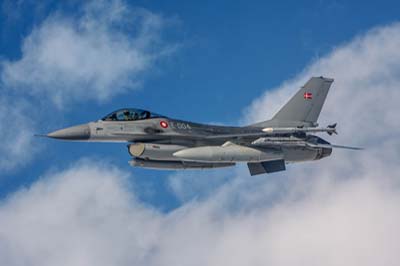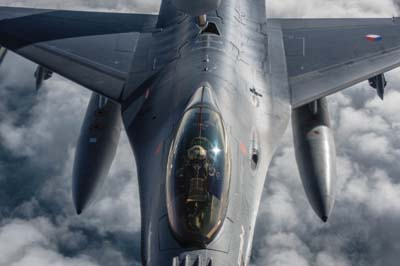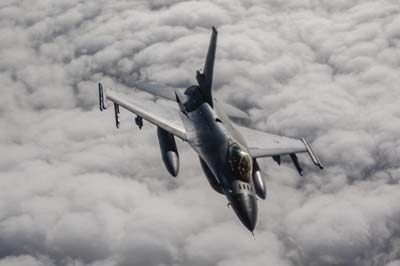Air to Air Photography
Exercise 'Bold Avenger 2009'
September 14-25, 2009
|
 With more than 50 participating aircraft from eleven NATO member nations, ‘Bold Avenger 2009’ (BAR09) was one of the largest exercises to be held this year for the European Expeditionary Air Wing (EEAW). The live firing exercise was centred on Karup Air Station in Denmark. The primary aim of BAR09 was to exercise and train participating units in a realistic environment, promoting mutual understanding and cooperation.
With more than 50 participating aircraft from eleven NATO member nations, ‘Bold Avenger 2009’ (BAR09) was one of the largest exercises to be held this year for the European Expeditionary Air Wing (EEAW). The live firing exercise was centred on Karup Air Station in Denmark. The primary aim of BAR09 was to exercise and train participating units in a realistic environment, promoting mutual understanding and cooperation.
In addition, BAR09 trained Joint Force Air Component (JFAC) elements in the running of specific air operations. The scenario for the exercise was based on a fictitious United Nations mandate, which required a NATO Response Force to deploy air units as part of multinational stabilisation force.
18 NATO nations and Sweden as a member of the Partnership-for-Peace program
(PfP) deployed around 800 personnel to Karup and to the Combined Air Operations Centre 1
(CAOC1) at Finderup.
Aircraft from Denmark, Belgium, the Czech Republic, France, Greece, the Netherlands, Norway, Portugal, Poland, Turkey and the United States were able to train together in a multinational environment under command and control of the Joint Force Air Component Commander (JFACC), Colonel Keith Pannabecker of the United States Air Force.
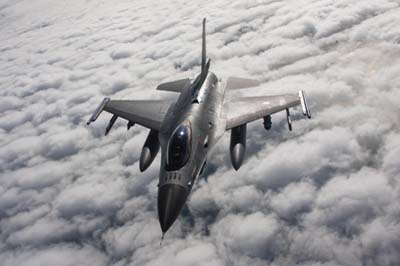
Aircraft operating from Karup included;
F-16AM of Esk 727/730 Royal Danish Air Force based at Skrysdstrup.
F-16AM of 2 Wing Belgian Air Component based at Florennes.
F-16C of 347 Mira Hellenic Air Force based at Néa Anchialos.
F-16AM of 331 Skv Norwegian Air Force based at Bodø.
An-26 of 242.tsl Czech Air Force based at Praha-Kbely.
F-16C/D of 10 Elt Polish Air Force based at Łask.
C-160R of ET00.064 French Air Force based at Evreux.
E-3F AWACS of EDC00.036 French Air Force based at Avord.
Mirage 2000N EC02.004 French Air Force based at Luxueil.
F-16C/D of 162 Filo Turkish Air Force based at Bandirma.
F-16AM of Esq 201 Portuguese Air Force based at Monte Real.
While most aircraft operated from Karup the RAF provided VC-10 tanker support from RAF Brize Norton and the USAF with KC-135R’s flew multiple air refuelling missions virtually every day from RAF Mildenhall. Other fighter aircraft participating included F-15E Strike Eagles operating from RAF Lakenheath, Dutch General Dynamics F-16AM Fighting Falcons of 322 Squadron from Leeuwarden and German F-4 Phantoms and Tornados with Finnish F-18’s which were flying from Neubrandenburg in Germany. A NATO Airborne Warning and Control (AWACS) E-3 aircraft normally based at Geilenkirchen in Germany was deployed to the Forward Operating Base at Ørland in Norway.
Ten flying days were scheduled with two packages of complimentary aircraft or Composite Air Operations (COMAO’s) flying each day in Danish, British, Norwegian, German and the Baltic air space.
In the first week over 400 sorties were flown, initially for crews to become familiar with local area procedures. Gradually the tempo and the complexity of the sorties increased building up to a COMAO which flew into Latvia and Lithuania to conduct the Baltic Region Training Event IV B which demonstrated NATO’s solidarity with the region. It also provided training for the Quick Reaction Alert (QRA), based at Šiauliai Airfield, Lithuania, where German Eurofighters are currently operating NATO’s air policing mission.
USAF KC-135’s provide essential fuel
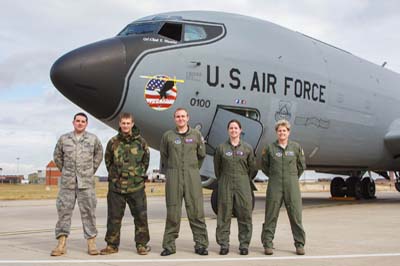 In the second week the complexity of the sorties increased further with more COMAO’s and Close Air Support (CAS) missions utilising additional ground units. For two days The NATO Electronic Warfare Force Integration Program (NEWFIP) with COMAO’s flying to attack the Electronic Warfare Tactics Range at RAF Spadeadam in northern England. There aircrews, to enhance their EW training, were able to practice manoeuvres and tactics against a variety of threats and targets which they would face in contemporary warfare. To enhance the EW scenario three DA-20 EW aircraft, one from the Royal Norwegian Air Force and two from Cobham Aviation Services and on contract to NATO, were deployed to Karup for the second week.
In the second week the complexity of the sorties increased further with more COMAO’s and Close Air Support (CAS) missions utilising additional ground units. For two days The NATO Electronic Warfare Force Integration Program (NEWFIP) with COMAO’s flying to attack the Electronic Warfare Tactics Range at RAF Spadeadam in northern England. There aircrews, to enhance their EW training, were able to practice manoeuvres and tactics against a variety of threats and targets which they would face in contemporary warfare. To enhance the EW scenario three DA-20 EW aircraft, one from the Royal Norwegian Air Force and two from Cobham Aviation Services and on contract to NATO, were deployed to Karup for the second week.
100th Air Refuelling Wing (ARW) and 351st Air Refuelling Squadron (ARS) based at RAF Mildenhall were tasked throughout the exercise to provide aerial refuelling. For the missions against Spadeadam 100 ARW were required to be on task over the North Sea with four Boeing KC-135R Stratotankers. Two aircraft were assigned to each of the neighbouring Air to Air Refuelling Areas (AARA) 8 and 9 on each of the two days in support of aircraft flying from Denmark and Holland.
 On the second day Lt Col Jennifer Crossman, 351 ARS Commander flew the 100 ARW Wing Commander’s aircraft (serial 58-0100). Col Chad Manske took charge of 100 ARW only two weeks earlier. Col Crossman’s co-pilot was Capt Nicole Shanks and the boom operator for ‘Texaco 63’ was SSgt Heath Tuma. ‘Texaco 63’ and ‘Texaco 64’ (62-3565) were required to be on task in AARA 8 for the morning COMAO inbound to Spadeadam. Both aircraft flew a racetrack pattern, ‘Texaco 63’ at 13,000 feet and ‘Texaco 64’ 4,000 feet higher on the opposite side of the racetrack for separation. Departing at 07:30 (local) we were soon on task as the first receivers, four Turkish General Dynamics F-16C/D Fighting Falcons’ were due at 08:10. At 08:07 the first aircraft appeared, a two-seat F-16D (89-0043) and flown by the flight leader callsign ‘Izmir 41’ in less than three minutes had received 6,000 pounds of JP-8 fuel. The other three Turkish aircraft, single-seat F-16C’s, each took 5,000 pounds of fuel before they were all on their way to the target by 08:23.
On the second day Lt Col Jennifer Crossman, 351 ARS Commander flew the 100 ARW Wing Commander’s aircraft (serial 58-0100). Col Chad Manske took charge of 100 ARW only two weeks earlier. Col Crossman’s co-pilot was Capt Nicole Shanks and the boom operator for ‘Texaco 63’ was SSgt Heath Tuma. ‘Texaco 63’ and ‘Texaco 64’ (62-3565) were required to be on task in AARA 8 for the morning COMAO inbound to Spadeadam. Both aircraft flew a racetrack pattern, ‘Texaco 63’ at 13,000 feet and ‘Texaco 64’ 4,000 feet higher on the opposite side of the racetrack for separation. Departing at 07:30 (local) we were soon on task as the first receivers, four Turkish General Dynamics F-16C/D Fighting Falcons’ were due at 08:10. At 08:07 the first aircraft appeared, a two-seat F-16D (89-0043) and flown by the flight leader callsign ‘Izmir 41’ in less than three minutes had received 6,000 pounds of JP-8 fuel. The other three Turkish aircraft, single-seat F-16C’s, each took 5,000 pounds of fuel before they were all on their way to the target by 08:23.
 Exactly on time at 08:25 were four F-16AM of the Norwegian Air Force using callsigns ‘Wolf 03’ to ‘Wolf 06’. Each aircraft initially took 6,000 pounds of fuel but they returned to take a 500 pound top-up before departing at 08:50.
Exactly on time at 08:25 were four F-16AM of the Norwegian Air Force using callsigns ‘Wolf 03’ to ‘Wolf 06’. Each aircraft initially took 6,000 pounds of fuel but they returned to take a 500 pound top-up before departing at 08:50.
Coyote 13 and 14’ two Royal Danish Air Force (RDAF) F-16AM’s were ten minutes early for their fuel. In fact a six ship was expected but the notes issued to the tanker commander by CAOC1 suggested that the leader may request three of his flight of six be diverted to ‘Texaco 64’ for their fuel, to speed up the turn round. The pair of F-16’s were on their way by 08:58 with an extra 6,000 pounds of fuel each.
‘Scarlet 01 and 02’ were two Royal Netherlands Air Force F-16AM’s, flying from Leeuwarden in northern Holland and were next to appear. They were due at 09:05 but did not arrive until 09:31 each taking just 4,000 pounds of fuel. They departed by 09:38 after they had formed a tactical formation behind the tanker for my camera.
 At 10:04 and just four minutes later ‘Izmir 41 to 44’ returned, their mission now complete they required additional fuel for their flight back to Denmark. Each aircraft received either 5,000 or 6,000 pounds of fuel. Now having more time the Turkish commander was able to stay on task for some additional minutes to form a four-ship line up before breaking away in style for the camera.
At 10:04 and just four minutes later ‘Izmir 41 to 44’ returned, their mission now complete they required additional fuel for their flight back to Denmark. Each aircraft received either 5,000 or 6,000 pounds of fuel. Now having more time the Turkish commander was able to stay on task for some additional minutes to form a four-ship line up before breaking away in style for the camera.
Finally ‘Coyote 07 and 08’ appeared at 10:26 following their attack on Spadeadam, they required fuel for the return journey. The RDAF F-16’s were not expected by our crew but were able to receive 5,000 pounds each. Other RDAF F-16’s were not so lucky and were turned away as our tanker was now short of fuel. The KC-135 departed with 165,000 pounds and during the three hour 20 minute sortie had given 99,000 pounds which was 4,000 pounds more than planned, to 18 receiving aircraft. The tanker eventually returned to Mildenhall with 22,000 pounds remaining and another successful air refuelling mission completed. The KC-135 can carry a maximum of 150,000 pounds of transfer fuel.
BAR09 was deemed to be a success. General Roger A. Brady, US Air Force, NATO’s Commander of air forces in the north of Europe at Ramstein Air Base, Germany when visiting Karup said; “The Danish Air Force has been a great host, all participating nations are getting really good training. We
are learning a lot about each other. I think this is a very beneficial exercise for everyone concerned.”
|
| Turkish Air Force - Turk Hava Kuvvetleri (THK), 162 Filo based at Bandirma. |
Norwegian Air Force - Luftforsvaret, 331 Skv based at Bodø.
|
Royal Danish Air Force - Kongelige Danske Flyvevåben, Esk 727/730 based at Skrysdstrup.
|
Royal Netherlands Air Force - Koninklijke Luchtmacht, 322 Squadron based at Leeuwarden.
|











